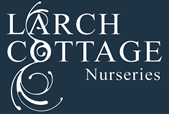News
Gardening for Butterflies
At Larch Cottage Nurseries and Gardens we have already spotted the first butterflies feasting on nectar in the borders: as early as mid-March a red admiral was seen feeding upon the offerings of a Maddenia hypoleuca growing in our perennial borders.
Providing a welcome habitat for butterflies in our garden becomes all the more important as the vagaries of the British weather challenge our pollinators, so a planting scheme incorporating nectar- rich sources is a welcome addition in any garden. Many summer annuals, bred for vibrancy and colour, do not provide adequate nectar levels for our butterflies, so including herbaceous perennials, biennials and shrubs is important. Buddleja is an obvious choice for the butterfly garden as it provides a ready source of nectar and masses of flowers, ensuring that the butterfly does not have far to travel for its next drink. Verbena bonariensis is also a good choice for similar reasons. While these two species are good for butterflies with long tongues, some thought should also be given to those shorter-tongued species who cannot access the deep nectar pools contained within these blooms: varieties of Sedum and the open flowers of the Asteraceae (daisy) family provide more accessible nectar for such species. Good choices include varieties of Aster, Coreopsis and Leucanthemum, amongst many others.
Excellent sources of nectar in early summer include Myosotis (forget-me-not), Primrose, Aubrieta, Erysimum, Prunus spinosa (blackthorn), Salix and Viola. Try to grow your plants in a sheltered, sunny position as butterflies like to prospect in warm sites.
Providing larveal plants for butterfly species is also an excellent idea if you want to encourage a wider range of species to your garden. Plants such as Alliaria petiolata (garlic mustard), Lunaria (honesty) and Cardamine pratensis (Lady’s Smock) are used by the larva of the orange-tip butterfly and the green-veined white; holly and ivy by the holly blue butterfly and Ribes (currant varieties) by the comma. Leaving an unmown area of long grass in your garden will also encourage meadow species such as the gatekeeper, small and large skipper and the speckled wood.
(Blog post written by Jo Chamberlain)


